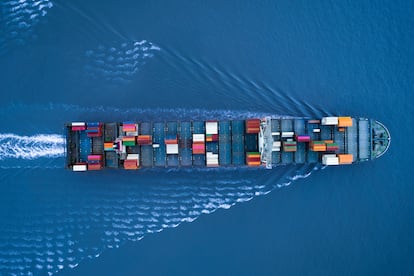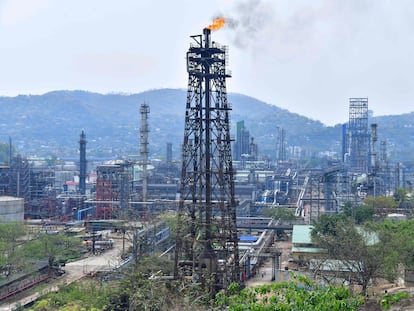Ghost trade: How Russia imports Mercedes Benz cars despite sanctions
Moscow is following Chinese and North Korean tactics so it can continue to bring in European goods and machinery

Until the winter of 2022, Moscow looked like a capitalist paradise. The new business district, Moscow City, had been filled with skyscrapers and was home to Europe’s largest shopping mall. Aviapark, located in the north of the Russian capital, boasted over 500 stores filled with Western brands and a world-record-breaking ornamental aquarium. Then, in February 2022, the start of the full-scale Ukrainian war triggered the exodus of over 1,000 foreign brands and that free-market illusion disappeared.
Eleven rounds of sanctions and 595 days of war later, buying an Adidas tracksuit or the new Mercedes-Benz in Russia is not so simple, but it can still be done. Trade flows throughout the war show that key consumer products and technology have continued to enter the country through various mechanisms that take advantage of the so-called gray market and countries that have economic ties to Moscow.
The gray market
A case in point: Parallel Majorka Import, an importer in the Russian capital, continues to bid on the latest models of European luxury cars, even though major European automakers have slowed their operations in Russia. “We bought a Mercedes-Benz W223 S400d from South Korea for use in Russia,” said a recent announcement on its Telegram channel, which has over 54,000 subscribers.
The German carmaker halted exports to Russia in March 2022 and pulled out completely last October, although cars were still coming in: between January and July of this year, 75,626 imported vehicles were registered in Russia, according to Russian Transport Ministry data.
Kazakhstan, Uzbekistan and Armenia, former members of the Soviet Union, have recorded historic increases in exports to Russia. Although these countries broke trade records, experts consulted by this newspaper suggest that China, the United Arab Emirates and other countries with ties to the Kremlin have continued to facilitate supplies.
These gray imports, acquired through a mechanism that the European Union and the international community consider to be non-compliance with their sanctions, not only include consumer goods, but also facilitate Russia’s import of key machinery, such as semiconductors and parts useful for the war industry.
Benjamin Hilgenstock, chief economist at the KSE Institute, notes that customs data throughout the war indicate that the Russian economy is recovering, despite the ruble’s decline. “Sanctions did not trigger a financial collapse in Russia, and that was not the goal. In my opinion, there is no reason to assume that there will be a recession in Russia. On the contrary, the economy will grow by 1% or 2% this year.”
Tactics for dodging the West’s sanctions
Agathe Demarais, a member of the European Council on Foreign Relations (ECFR), believes that the Kremlin has taken its cues from North Korea, Iran, and China to shield itself from Western sanctions. “[Russia] has used North Korea as a model for disguising ships and manipulating automatic ship tracking systems. They are experts in importing coal and oil under the table, a technique Russia uses today.”
The KSE Institute figures that Russia has circumvented oil sanctions through a “dark fleet” of an estimated 156 tankers that travel without protection and indemnity insurance, a requirement in most Western seaports.
“We believe Russia has been able to find alternative sea routes, for example, through Chinese ports that do not require this insurance,” Hilgenstock added.
Demarais believes that Russia and Iran have diversified their trade routes in the face of international sanctions. Since 2000, Tehran and Moscow have been working on the International North-South Transport Corridor, an alternative trade route.
The test launch of the new digital ruble, modeled on the digital yuan, could render Western sanctions completely ineffective if Moscow succeeds in linking it to the international market, the expert says. China leads the way in alternative payment methods, boasting tens of millions of users of the Central Bank of China-controlled currency, which has enormous tracking capabilities.
Imports through third-party countries
To replace semiconductors — which are useful for everything from smartphones to warfare and intelligence technology — from the United States, Russia has begun importing them from Turkey and China. According to Global Trade Tracker estimates, exports of such products from Ankara have jumped by about 200% since 2021 and continue to grow.
In recent years, Kazakhstan, which shares the longest land border with Russia, has seen the most significant increase in trade flows, according to data cross-referenced with Bloomberg, Bruegel and several countries’ customs records. Russia imported 390% more goods from this Central Asian country between April 2022 and April of this year.
Most of the goods registered in databases were vehicles and other commercial products. In turn, German vehicles crossing Kazakh borders increased by 257% between 2022 and 2023. In the past year, Russian business has also moved closer to Astana, as two leaders in Russian e-commerce, Ozon and Wildberries, moved their warehouses to Kazakhstan.
In sum, European product imports bound for Kazakhstan rose by 290% between January 2022 and 2023, according to Bloomberg figures. Armenia also saw an exponential increase in imports from the Eurozone, with a jump of over 91% during the same period.
Because products pass through a third country, it is difficult for multinationals to track where their own goods end up, even if they no longer have competitors in the market. Valeria Enrich, a partner at Baker McKenzie Barcelona, advises these companies to “find out who is buying their products,” and put measures in place before exporting with an unknown entity.
EU attempts to rein in ghost trade flows
European Union and U.S. agencies have identified ghost trade flows in several of the countries mentioned. In its most recent sanctions package last July, Brussels warned that, in exceptional cases, third-country firms facilitating this gray market may also be sanctioned. A European Commission official, speaking on the condition of anonymity, said that these measures are exceptional for now and that “changes in attitude will come slowly.”
“[The fact] that the war in Ukraine has caused a massive boom in trade flows is not discussed,” Timothy Ash, of the Chatham House think tank, told this newspaper. “These countries have benefited massively from the war and should now return some of that windfall.”
Ash suggests that the latest sanctions signal a push for those third countries to self-regulate, but he adds that it is a delicate balancing act. “The CIS countries will have to decide which relationship is more important. I don’t think any of them want to get on the bad side of the Western sanctions regime, particularly the banks.”
Sign up for our weekly newsletter for more English-language news coverage from EL PAÍS USA Edition
Tu suscripción se está usando en otro dispositivo
¿Quieres añadir otro usuario a tu suscripción?
Si continúas leyendo en este dispositivo, no se podrá leer en el otro.
FlechaTu suscripción se está usando en otro dispositivo y solo puedes acceder a EL PAÍS desde un dispositivo a la vez.
Si quieres compartir tu cuenta, cambia tu suscripción a la modalidad Premium, así podrás añadir otro usuario. Cada uno accederá con su propia cuenta de email, lo que os permitirá personalizar vuestra experiencia en EL PAÍS.
¿Tienes una suscripción de empresa? Accede aquí para contratar más cuentas.
En el caso de no saber quién está usando tu cuenta, te recomendamos cambiar tu contraseña aquí.
Si decides continuar compartiendo tu cuenta, este mensaje se mostrará en tu dispositivo y en el de la otra persona que está usando tu cuenta de forma indefinida, afectando a tu experiencia de lectura. Puedes consultar aquí los términos y condiciones de la suscripción digital.
More information
Archived In
Últimas noticias
Most viewed
- Alain Aspect, Nobel laureate in physics: ‘Einstein was so smart that he would have had to recognize quantum entanglement’
- Mexico’s missing people crisis casts a shadow over World Cup venue
- Why oil has been at the center of Venezuela-US conflicts for decades
- Trump clarifies who is ultimately in charge in Venezuela: ‘Me’
- Mexico seeks to shore up its defenses following US incursion in Venezuela











































